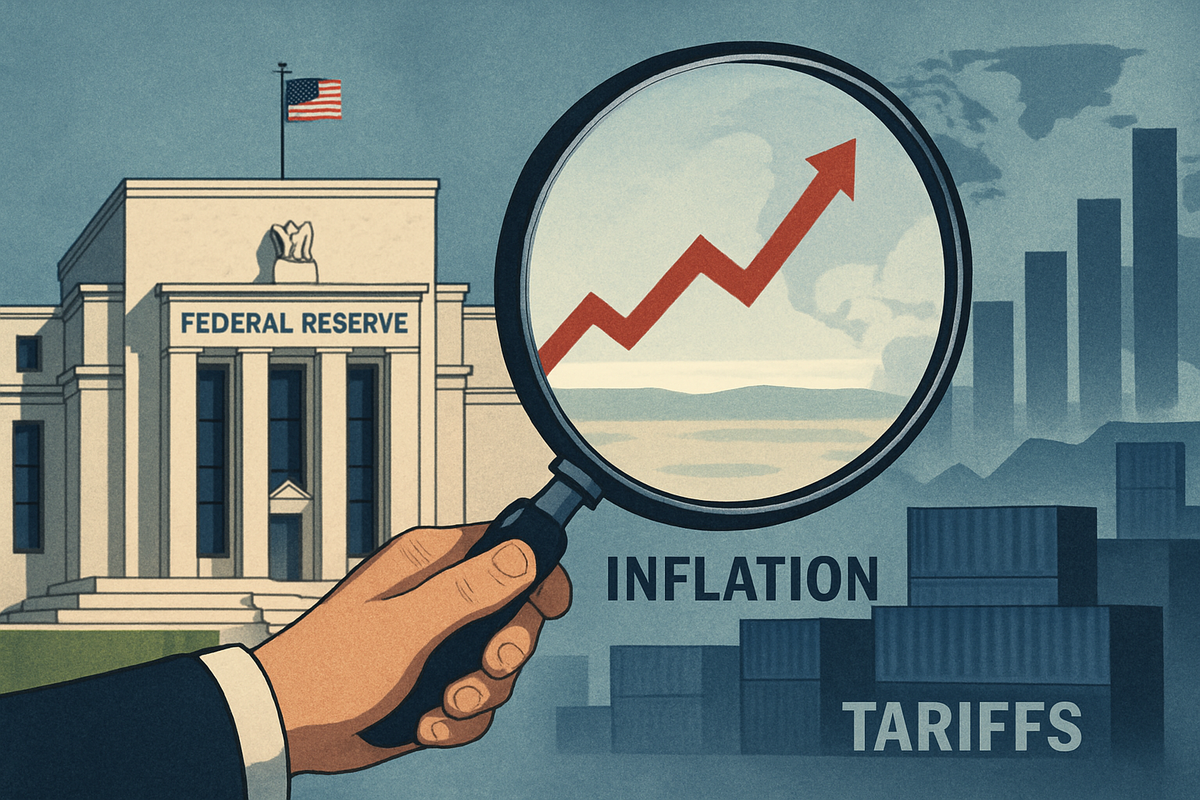
Philadelphia, PA – October 13, 2025 – In a significant address delivered today, Philadelphia Federal Reserve President Anna Paulson articulated a clear and compelling perspective on tariff-driven inflation, signaling the Federal Reserve's inclination to "look through" such price increases. Her remarks, made at the National Association for Business Economics' annual conference, suggest that these specific inflationary pressures are unlikely to derail the Fed's trajectory towards further interest rate cuts this year, with Paulson herself favoring two more quarter-point reductions in 2025. This stance underscores a critical balancing act by the central bank: mitigating emerging risks to the labor market while maintaining price stability amidst global trade complexities.
Paulson's comments offer crucial insight into the Federal Open Market Committee's (FOMC) thinking, particularly as the economy navigates persistent trade tensions and a cooling labor market. By distinguishing between temporary price level adjustments caused by tariffs and sustained inflationary trends, the Fed aims to avoid tightening monetary policy unnecessarily in response to supply-side shocks. This strategic approach could provide the necessary flexibility for the central bank to continue easing monetary conditions, thereby supporting economic growth and employment in the face of increasing downside risks to the job market.
Paulson's Tariff Calculus: A Deeper Dive into the Fed's Stance
Philadelphia Fed President Anna Paulson's inaugural major economic outlook speech today, October 13, 2025, laid out a nuanced framework for how the Federal Reserve intends to address tariff-driven inflation. Her central tenet is that while tariffs undeniably elevate the price level, they do not, by their nature, instigate sustained inflation—a distinction critical for monetary policy. Paulson vividly described this as tariffs being "peas being digested" by the economy, implying their effects are transient rather than enduring. This "base case" is predicated on several key observations.
Firstly, Paulson emphasized the continued anchoring of inflation expectations, which she views as paramount. As long as businesses and consumers do not anticipate higher prices to persist indefinitely, temporary shocks like tariffs are less likely to spiral into a wage-price feedback loop. Secondly, she pointed to the current state of the labor market, noting that it is not exhibiting the characteristics that would allow tariff-induced price hikes to translate into broader, sustained inflation. Paulson highlighted signs of a cooling labor market, with some contacts even reporting lower starting wages, a stark contrast to the intense wage pressures observed during the post-pandemic recovery. Lastly, the actual pass-through of tariff costs to consumers has been more limited than initially feared, with many businesses absorbing some of the costs to preserve market share, thus dampening the inflationary impulse.
The "look through" approach advocated by Paulson is not novel; it echoes sentiments from other prominent Fed officials, including governors Christopher Waller and Stephen Miran, and even Chair Jerome Powell, who have previously suggested treating tariff impacts as "one-time effects." However, the context of 2025 differs from earlier periods, such as 2018-2019, when similar discussions occurred. With inflation having recently run above the Fed's 2% target, some FOMC participants remain cautious about fully overlooking tariff effects, particularly if they prove more persistent or begin to influence long-term expectations. Despite these reservations, Paulson's clear articulation of this strategy provides a strong signal of the Fed's current leanings, prioritizing the broader economic picture over transient price fluctuations.
Market Movers: Companies Poised to Win or Lose from Tariff Policy and Rate Cuts
The Federal Reserve's "look through" approach to tariff-driven inflation, coupled with the prospect of further rate cuts, presents a complex landscape for various public companies. Industries heavily reliant on global supply chains and those sensitive to consumer spending and borrowing costs will feel the most significant impacts.
Companies that import a substantial portion of their goods or raw materials, particularly from regions subject to tariffs, have historically borne the brunt of these trade policies. For example, consumer electronics giants like Apple (NASDAQ: AAPL) and Samsung (KRX: 005930), automotive manufacturers such as Ford (NYSE: F) and General Motors (NYSE: GM), and various retailers like Walmart (NYSE: WMT) and Target (NYSE: TGT), often face increased input costs due to tariffs. Paulson's "look through" stance, while not eliminating tariffs, suggests the Fed won't compound their negative effects with higher interest rates. This could provide some relief, as lower borrowing costs might offset some of the tariff-induced cost pressures, allowing these companies to invest more in domestic production or supply chain diversification without facing prohibitive financing expenses. However, if tariffs persist and companies cannot fully pass on costs, their profit margins could still be squeezed, even with lower interest rates.
Conversely, domestic manufacturers and companies with robust U.S.-based supply chains might find themselves in a relatively stronger position. Industries like steel production (e.g., U.S. Steel (NYSE: X), Nucor (NYSE: NUE)) or certain segments of agriculture, which could benefit from reduced foreign competition due to tariffs, might see increased demand. Furthermore, the prospect of lower interest rates makes capital more affordable, potentially stimulating domestic investment and expansion. Companies in sectors that thrive on consumer credit, such as housing (e.g., D.R. Horton (NYSE: DHI)) and large-ticket retail, could also see a boost as borrowing becomes cheaper for consumers. Technology companies that rely on venture capital or significant R&D investments might also benefit from a lower cost of capital, facilitating growth and innovation. The key for all these players will be their ability to adapt to changing trade dynamics while leveraging the opportunities presented by a more accommodative monetary policy environment.
Wider Significance: Navigating Trade, Inflation, and Monetary Policy Crossroads
Philadelphia Fed President Anna Paulson's articulation of the "look through" strategy for tariff-driven inflation marks a significant juncture in the Federal Reserve's ongoing efforts to balance its dual mandate. This approach is not merely a technical adjustment; it represents a philosophical stance on how the central bank interprets and responds to specific types of price pressures in a globalized yet increasingly protectionist economic environment. It signals a prioritization of broader economic stability—particularly labor market health—over immediate, transient price fluctuations stemming from trade policy.
This event fits squarely into the broader industry trend of central banks grappling with supply-side shocks that are often beyond their direct control. Unlike demand-driven inflation, which can be effectively cooled by raising interest rates, tariff-induced price increases are a direct consequence of government trade policy. For the Fed to react aggressively with rate hikes to such shocks could risk stifling economic growth and employment without effectively addressing the root cause of the price increases. This aligns with historical precedents where central banks have often distinguished between "headline" inflation (which includes volatile items like energy or food, or in this case, tariff impacts) and "core" inflation, which is seen as a better indicator of underlying inflationary trends. The 2018-2019 trade war period saw similar debates within the Fed, though the current environment in 2025 has the added complexity of recent above-target inflation.
The potential ripple effects extend to international trade relations and regulatory policy. If the Fed consistently "looks through" tariff impacts, it might inadvertently remove some of the domestic economic pressure points that could otherwise compel policymakers to reconsider protectionist trade measures. This could empower governments to implement tariffs with less immediate domestic economic blowback, potentially exacerbating global trade tensions. Competitors and partners abroad will closely watch how U.S. monetary policy reacts to trade barriers, influencing their own policy decisions and investment strategies. Furthermore, this stance implicitly acknowledges the limitations of monetary policy in addressing issues fundamentally rooted in fiscal or trade policy, highlighting the need for coordinated governmental approaches to achieve optimal economic outcomes.
What Comes Next: A Path Towards Strategic Easing and Market Adaptations
The Federal Reserve's commitment to "looking through" tariff-driven inflation, as articulated by President Paulson, sets the stage for a period of strategic monetary easing. In the short term, this reinforces the likelihood of the two additional quarter-point rate cuts Paulson signaled for 2025, aligning with the median policy path from the Fed's Summary of Economic Projections. These cuts are primarily a "risk-management strategy" aimed at counteracting the "downside momentum" and "increasing" risks in the labor market. Businesses and consumers can anticipate a sustained environment of lower borrowing costs, which should provide a tailwind for investment, hiring, and consumption, particularly in interest-rate-sensitive sectors.
In the long term, this approach suggests a Fed that is highly attuned to the nature of inflation, rather than just its headline number. Should future price pressures emerge from supply-side shocks, the central bank may continue to exercise caution before resorting to aggressive rate hikes, provided inflation expectations remain anchored. This could lead to a more nuanced and potentially more stable monetary policy framework, where the Fed reserves its most potent tools for demand-driven inflationary spirals. However, a critical challenge will be ensuring that the public and markets continue to differentiate between temporary price level adjustments and persistent inflation, preventing any erosion of inflation expectations.
Market opportunities will likely emerge in sectors that benefit most from lower interest rates and a stable, albeit tariff-affected, economic environment. Companies with high capital expenditure needs, those reliant on consumer financing, and growth-oriented firms may find it easier to secure funding and expand. Conversely, challenges may arise for companies heavily exposed to persistent tariffs if they cannot innovate or diversify their supply chains, as the Fed's policy only mitigates the monetary response, not the direct cost of tariffs. Potential scenarios include a gradual economic rebalancing towards domestic production, or, if tariffs intensify, a prolonged period of slightly higher input costs for certain industries, absorbed partly by corporate margins and partly by consumers, but without triggering a broader inflationary spiral that would necessitate aggressive Fed intervention.
Comprehensive Wrap-Up: A Balanced Approach for a Complex Economy
Philadelphia Fed President Anna Paulson's recent statements on tariff-driven inflation represent a pivotal moment for the Federal Reserve's monetary policy in 2025. The key takeaway is the Fed's intent to "look through" the immediate price increases caused by tariffs, treating them as temporary supply shocks rather than signals of persistent, broad-based inflation. This nuanced perspective is underpinned by the belief that inflation expectations remain anchored and that current labor market conditions do not support a sustained inflationary spiral from tariffs alone. This strategy directly supports the possibility of further interest rate cuts—Paulson herself advocating for two more quarter-point reductions—aimed at managing downside risks to the labor market and guiding the economy towards a more neutral monetary stance.
Moving forward, the market will likely view this as a commitment by the Fed to prioritize employment stability while carefully distinguishing between different sources of inflation. Investors should watch for continued data on inflation expectations, the health of the labor market, and the actual pass-through rates of tariffs. Any signs that tariffs are beginning to influence long-term inflation expectations or significantly impacting wage growth could prompt a re-evaluation of the "look through" approach by some FOMC members.
Ultimately, Paulson's remarks underscore the increasing complexity of monetary policy in an era marked by geopolitical trade tensions and evolving economic structures. The Fed is attempting to walk a fine line, preventing tariff-induced price hikes from triggering an unnecessary tightening cycle, while remaining vigilant against genuine inflationary threats. This balanced, data-dependent approach will be crucial for maintaining economic stability and fostering sustainable growth in the coming months, offering both opportunities and challenges for businesses and investors alike.
This content is intended for informational purposes only and is not financial advice





